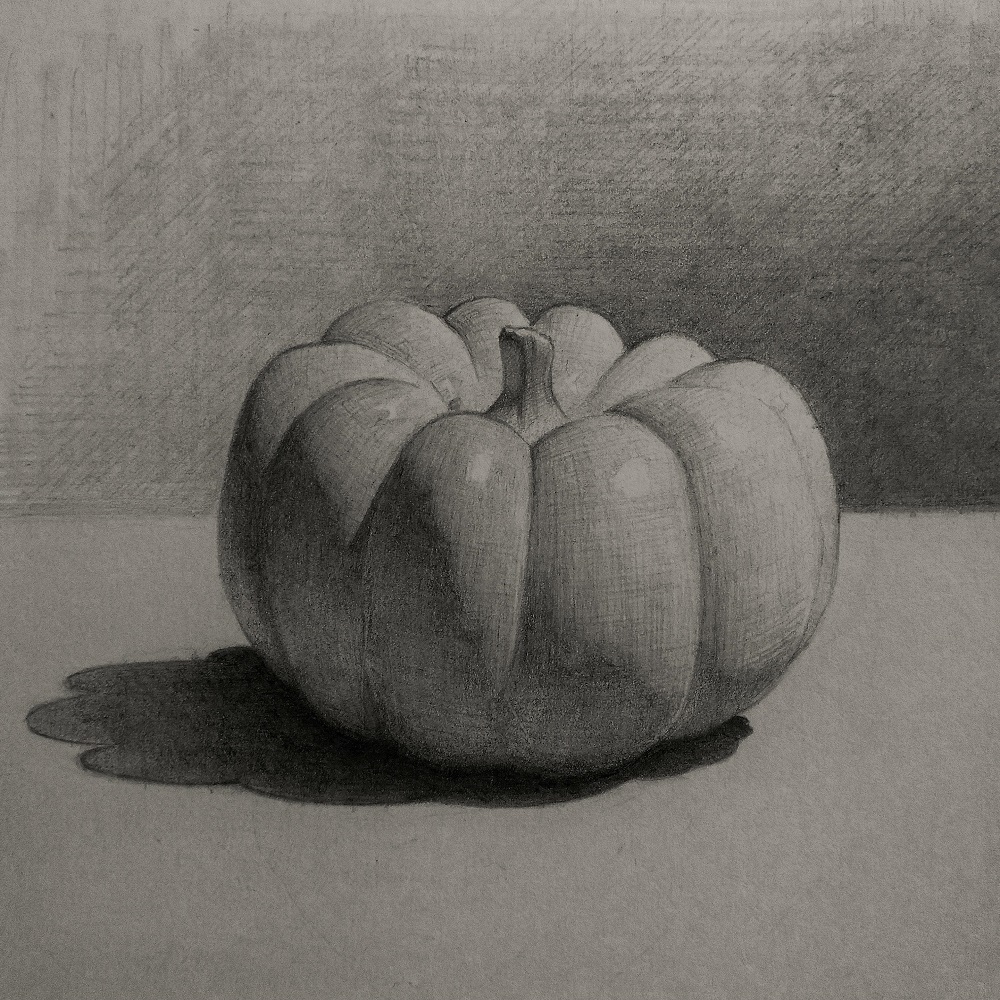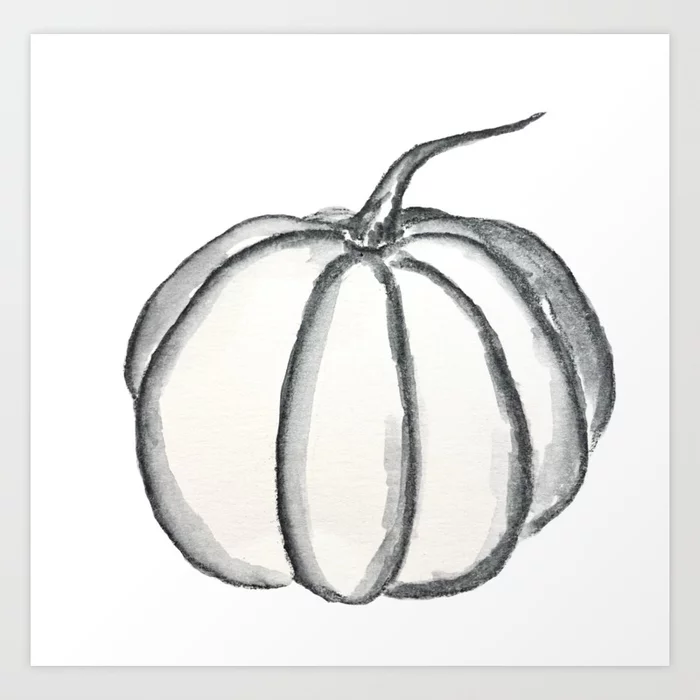Charcoal is a versatile medium that offers a unique and striking quality to art. Charcoal Pumpkin Drawing can bring out stunning contrasts and textures, making them an ideal subject for your next art project. Here are some creative ideas to get you inspired.
Realistic Pumpkin
Capturing the Details
Start with a realistic pumpkin to practice your observational skills. Focus on capturing the intricate details of the pumpkin’s surface, such as the grooves, ridges, and lumps. Use fine charcoal pencils for detailed work and broad strokes for shading. Begin by lightly sketching the outline of the pumpkin, paying attention to its shape and proportions. Gradually build up the texture with cross-hatching and blending techniques to create depth and dimension. Notice the subtle variations in the surface texture; these details make the drawing lifelike.
The key to a realistic pumpkin lies in mastering these small details. Carefully observe the way light interacts with the surface, highlighting some areas while casting shadows on others. This approach allows you to create a drawing that feels tangible and three-dimensional. Capturing these nuances enhances the realism and depth of your work. Detailed rendering not only makes the pumpkin appear more lifelike but also improves your skills in texture and shading.
Shading and Highlights
Shading is crucial for achieving a realistic effect. Identify the light source in your reference or setup and use it to guide your shading. Apply darker tones to the shadowed areas and lighter tones to the highlights. Use a blending stump or your fingers to smooth out transitions between light and dark areas for a more cohesive look. Incorporate a variety of shading techniques, such as stippling, hatching, and cross-hatching, to create a rich tapestry of textures.
Contrasts between light and dark areas are what make the drawing dynamic and engaging. Highlights can be achieved by erasing parts of the charcoal to reveal the light beneath, or by adding white chalk for extra brightness. The strategic placement of highlights and shadows creates a sense of volume and depth, making the pumpkin appear three-dimensional. Proper shading techniques enhance this effect, bringing your pumpkin to life on the paper.

Abstract Pumpkin
Playing with Shapes
Create an abstract pumpkin to unleash your creativity. Focus on unconventional shapes and exaggerated forms, moving away from traditional representations. Use angular lines, curves, and geometric patterns to give your pumpkin an artistic twist. Start by sketching traditional pumpkin shapes, then modify them to create abstract forms. Experiment with different angles, proportions, and perspectives to keep the composition engaging and dynamic.
Abstract art allows you to break the rules and interpret the subject in your unique way. Play with distorted and fragmented shapes, and intertwine them to create interesting visual patterns. This approach makes the drawing more than just a representation—it turns into a piece of art that expresses emotion and creativity. Using varied shapes adds a distinct character to the artwork, transforming a simple pumpkin into a unique artistic expression.
Experimenting with Texture
Charcoal is excellent for creating varied textures. Use different techniques such as stippling, scribbling, and smudging to add texture to your abstract pumpkin. Experiment with layering charcoal to build rich, tactile surfaces. Incorporating rubbing and blending can also create interesting effects that enhance the texture of your drawing.
The key to a successful abstract piece is creating a balance between different textures and forms. Use soft and hard charcoal to achieve a range of textures, from smooth gradients to rough, gritty surfaces. Combining these techniques can add depth and intrigue to your drawing. Textured surfaces provide visual interest and richness, making your abstract pumpkin more compelling. Experimenting with texture enriches the abstract quality of your charcoal pumpkin drawing, transforming it into a multifaceted piece of art.

Pumpkin Still Life
Setting the Scene
Create a still life composition with a pumpkin as the centerpiece. Place the pumpkin in a natural or rustic setting and add complementary elements like leaves, candles, or a basket. The arrangement should create a balanced and harmonious scene, enhancing the visual appeal of your drawing. Consider the background and how it interacts with the foreground objects; both play a crucial role in setting the overall mood.
The composition should guide the viewer’s eye through the elements, creating a cohesive and engaging piece. Pay attention to the relationship between light and shadow, and how they interact with each element. Using the rule of thirds can help you place the focal point in a way that draws attention. A well-composed still life not only highlights the pumpkin but also tells a story. Setting the scene thoughtfully enhances the overall impact of your drawing, making it more compelling and visually satisfying.
Focus on Composition
Composition is a fundamental aspect of still life drawing. Use the rule of thirds to place the focal point, ensuring the pumpkin is positioned to draw the viewer’s eye. Ensure that the elements around the pumpkin guide the viewer’s gaze naturally through the composition. The contrast between light and dark areas, as well as the arrangement of objects, adds to the overall composition.
Use directional lines and shapes within the composition to lead the viewer’s gaze from one element to another. The careful arrangement helps create a sense of balance and harmony. Consider using overlapping objects and varying sizes to create depth and dimension within the scene. A strong composition not only makes your pumpkin still life aesthetically pleasing but also engaging. Good composition techniques elevate the artistic quality of your work, making it more than just a drawing—it becomes a visual experience.

Pumpkin in Nature
Adding Surrounding Elements
Place the pumpkin in a lush natural setting to make the scene more dynamic. Surround it with elements like vines, leaves, and soil to capture the essence of autumn. Use charcoal’s versatility to depict the organic textures of nature, enhancing the realism and depth of your drawing. Start by sketching the pumpkin, then gradually add the surrounding elements, carefully considering their placement to create harmony and balance.
Pay attention to how the pumpkin interacts with its environment. For example, vines may wrap around the pumpkin, or leaves might cast shadows on it. These interactions add a sense of realism and context, making the drawing feel like a snapshot of a moment in nature. Adding natural elements creates a cohesive and harmonious scene, providing a rich backdrop that complements the pumpkin.
Capturing Light and Shadow
Natural settings often have complex lighting. Observe how light filters through leaves and casts shadows on the pumpkin and surrounding elements. Use these observations to guide your shading practices. The interplay of light and shadow can add a dynamic quality to your drawing.
Apply darker tones to shadowed areas and lighter tones where light hits. Blending techniques can help you create soft transitions between these areas. Pay attention to the subtleties of light, like the way it penetrates through foliage or bounces off surfaces. Capturing light and shadow accurately enhances the realistic quality of your drawing. Proper lighting techniques make your nature-inspired charcoal pumpkin drawing come alive, adding depth and authenticity.
Whimsical Pumpkin
Imaginative Elements
A whimsical pumpkin drawing is the perfect opportunity to get creative and have fun. Add imaginative and fantastical elements to your pumpkin, such as playful faces, intricate patterns, or surreal motifs. Let your imagination be the guide, pushing the boundaries of traditional pumpkin portrayal.
Start with a basic pumpkin shape, then embellish it using flowing lines, whimsical patterns, and surreal elements. Incorporate features like exaggerated facial expressions or quirky accessories to give the pumpkin a unique personality. Imaginative elements make the pcharcoal pumpkin drawing playful and unique, adding a touch of fantasy and fun. Whimsical drawings allow for creative expression and bring a sense of joy and creativity to your art.
Using Charcoal Creatively
Experiment with charcoal to create whimsical effects. Use the medium’s flexibility to your advantage by combining different textures and techniques. Explore the use of contrasting elements like white chalk or colored pencils to add vibrancy and highlight certain areas.
Layering charcoal in playful patterns and blending can create interesting textures and effects. Try different charcoal grades to achieve varied textures and add depth. Creatively combining materials and techniques brings out the magical essence of your charcoal pumpkin drawing. This approach encourages experimentation and opens up a world of creative possibilities.
Pumpkin Portraits
Focus on Close-ups
Pumpkin portraits involve zooming in on specific areas to capture intricate details. Focus on the surface texture, such as the patterns and natural blemishes. Use detailed shading techniques to emphasize depth and dimension in these close-up views.
Zoom in on a section of the pumpkin that highlights its unique features. Carefully sketch the details and textures, capturing the nuances that make the pumpkin interesting. Close-up portraits reveal the beauty of the pumpkin’s natural form and allow you to hone your skills in detailed rendering. Detailed pumpkin portraits highlight your craftsmanship and ability to capture intricate details with charcoal.
Adding Character
Give your pumpkin portrait character by emphasizing its unique features. Add subtle details like a twisted stem or uneven surface to highlight individuality. These imperfections add personality and make the pumpkin more relatable and engaging.
Use shading and highlights to enhance these features. The contrasts will bring out the character and individuality of the pumpkin, adding to its visual appeal. Drawing attention to distinct characteristics makes your pumpkin portrait more captivating. Personalized details bring your charcoal pumpkin drawing to life, making it stand out as a unique piece of art.